Choosing a Gaming CPU at 1440p: Adding in Haswell
by Ian Cutress on June 4, 2013 10:00 AM ESTFor an article like this getting a range of CPUs, which includes the most common and popular, is very important. I have been at AnandTech for just over two years now, and in that time we have had Sandy Bridge, Llano, Bulldozer, Sandy Bridge-E, Ivy Bridge, Trinity and Vishera, of which I tend to get supplied the top end processors of each generation for testing (as a motherboard reviewer, it is important to make the motherboard the limiting factor). A lot of users have jumped to one of these platforms, although a large number are still on Wolfdale (Core2), Nehalem, Westmere, Phenom II (Thuban/Zosma/Deneb) or Athlon II. I have attempted to pool all my AnandTech resources, contacts, and personal resources, together to get a good spread of the current ecosystem, with more focus on the modern end of the spectrum. It is worth nothing that a multi-GPU user is more likely to have the top line Ivy Bridge, Vishera or Sandy Bridge-E CPU, as well as a top range motherboard, rather than an old Wolfdale. Nevertheless, we will see how they perform. There are a few obvious CPU omissions that I could not obtain for this first review which will hopefully be remedied over time in our next update.
The CPUs
My criteria for obtaining CPUs was to use at least one from the most recent architectures, as well as a range of cores/modules/threads/speeds. The basic list as it stands is:
AMD |
|||||||
| Name |
Platform / Architecture |
Socket |
Cores / Modules (Threads) |
Speed | Turbo | L2/L3 Cache | |
|---|---|---|---|---|---|---|---|
| A6-3650 | Llano | FM1 | 4 (4) | 2600 | N/A | 4 MB / None | |
| A8-3850 | Llano | FM1 | 4 (4) | 2900 | N/A | 4 MB / None | |
| A8-5600K | Trinity | FM2 | 2 (4) | 3600 | 3900 | 4 MB / None | |
| A10-5800K | Trinity | FM2 | 2 (4) | 3800 | 4200 | 4 MB / None | |
| Phenom II X2-555 BE | Callisto K10 | AM3 | 2 (2) | 3200 | N/A | 1 MB / 6 MB | |
| Phenom II X4-960T | Zosma K10 | AM3 | 4 (4) | 3200 | N/A | 2 MB / 6 MB | |
| Phenom II X6-1100T | Thuban K10 | AM3 | 6 (6) | 3300 | 3700 | 3 MB / 6 MB | |
| FX-8150 | Bulldozer | AM3+ | 4 (8) | 3600 | 4200 | 8 MB / 8 MB | |
| FX-8350 | Piledriver | AM3+ | 4 (8) | 4000 | 4200 | 8 MB / 8 MB | |
Intel |
|||||||
| Name | Architecture | Socket |
Cores / Modules (Threads) |
Speed | Turbo | L2/L3 Cache | |
| E6400 | Conroe | 775 | 2 (2) | 2133 | N/A | 2 MB / None | |
| E6550 | Conroe | 775 | 2 (2) | 2333 | N/A | 4 MB / None | |
| E6700 | Conroe | 775 | 2 (2) | 2667 | N/A | 4 MB / None | |
| Q9400 | Yorkfield | 775 | 4 (4) | 2667 | N/A | 6 MB / None | |
| Xeon X5690 | Westmere | 1366 | 6 (12) | 3467 | 3733 | 1.5 MB / 12 MB | |
| Celeron G465 | Sandy Bridge | 1155 | 1 (2) | 1900 | N/A | 0.25 MB / 1.5 MB | |
| Core i5-2500K | Sandy Bridge | 1155 | 4 (4) | 3300 | 3700 | 1 MB / 6 MB | |
| Core i7-2600K | Sandy Bridge | 1155 | 4 (8) | 3400 | 3800 | 1 MB / 8 MB | |
| Core i7-3930K | Sandy Bridge-E | 2011 | 6 (12) | 3200 | 3800 | 1.5 MB / 12 MB | |
| Core i7-3960X | Sandy Bridge-E | 2011 | 6 (12) | 3300 | 3900 | 1.5 MB / 15 MB | |
| Core i3-3225 | Ivy Bridge | 1155 | 2 (4) | 3300 | N/A | 0.5 MB / 3 MB | |
| Core i7-3770K | Ivy Bridge | 1155 | 4 (8) | 3500 | 3900 | 1 MB / 8 MB | |
| Core i7-4770K | Haswell | 1150 | 4 (8) | 3500 | 3900 | 1 MB / 8 MB | |
There omissions are clear to see, such as the i7-3570K, a dual core Llano/Trinity, a dual/tri module Bulldozer/Piledriver, i7-920, i7-3820, or anything Nehalem. These will hopefully be coming up in another review.
The GPUs
My first and foremost thanks go to both ASUS and ECS for supplying me with these GPUs for my test beds. They have been in and out of 60+ motherboards without any issue, and will hopefully continue. My usual scenario for updating GPUs is to flip AMD/NVIDIA every couple of generations – last time it was HD5850 to HD7970, and as such in the future we will move to a 7-series NVIDIA card or a set of Titans (which might outlive a generation or two).
The ASUS HD 7970 we use is the reference model at the 7970 launch, using GCN architecture, 2048 SPs at 925 MHz with 3 GB of 4.6 GHz GDDR5 memory. We have four cards to be used in 1x, 2x, 3x and 4x configurations where possible, also using PCIe 3.0 when enabled by default.
ECS GTX 580 (NGTX580-1536PI-F)
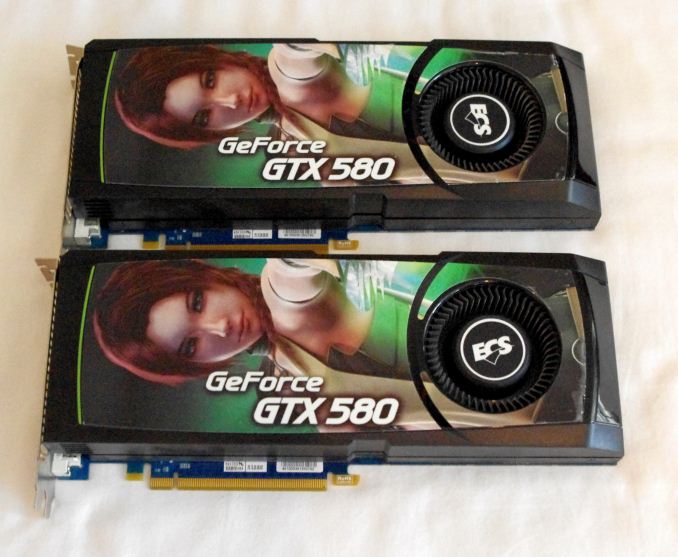
ECS is both a motherboard manufacturer and an NVIDIA card manufacturer, and while most of their VGA models are sold outside of the US, some do make it onto e-e-tailers like Newegg. This GTX 580 is also a reference model, with 512 CUDA cores at 772 MHz and 1.5 GB of 4 GHz GDDR5 memory. We have two cards to be used in 1x and 2x configurations at PCIe 2.0.
The Motherboards
The CPU is not always the main part of the picture for this sort of review – the motherboard is equally important as the motherboard dictates how the CPU and the GPU communicates with each other, and what the lane allocation will be. As mentioned on the previous page, there are 20+ PCIe configurations for Z77 alone when you consider some boards are native, some use a PLX 8747 chip, others use two PLX 8747 chips, and about half of the Z77 motherboards on the market enable four PCIe 2.0 lanes from the chipset for CrossFireX use (at high latency). We have tried to be fair and take motherboards that may have a small premium but are equipped to deal with the job. As a result, some motherboards may also use MultiCore Turbo, which as we have detailed in the past, gives the top turbo speed of the CPU regardless of the loading.
As a result of this lane allocation business, each value in our review will be attributed to both a CPU, whether it uses MCT, and a lane allocation. This would mean something such as i7-3770K+ (3 - x16/x8/x8) would represent an i7-3770K with MCT in a PCIe 3.0 tri-GPU configuration. More on this below.
For Haswell: Gigabyte Z87X-UD3H, ASUS Z87-Pro, and MSI Z87-GD65 Gaming
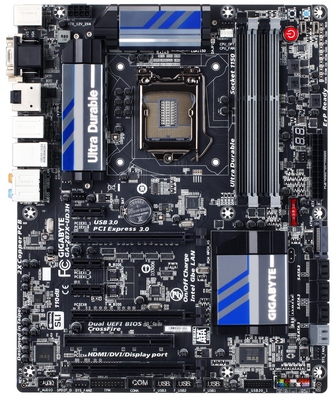
The ASUS Z87-Pro nominally offers an PCIe 3.0 x8/x8 layout with an additional PCIe 2.0 x4 from the PCH, however this starts in x1 mode without a change in the BIOS.
The MSI Z87A-GD65 gives us PCI 3.0 x8/x4/x4.
The Gigabyte Z87X-UD3H gives PCIe 3.0 x8/x8 + PCIe 2.0 x4, but this motherboard was tested with MCT off.
For Sandy Bridge and Ivy Bridge: ASUS Maximus V Formula, Gigabyte Z77X-UP7 and Gigabyte G1.Sniper M3

The ASUS Maximus V Formula has a three way lane allocation of x8/x4/x4 for Ivy Bridge, x8/x8 for Sandy Bridge, and enables MCT.
The Gigabyte Z77X-UP7 has a four way lane allocation of x16/x16, x16/x8/x8 and x8/x8/x8/x8, all via a PLX 8747 chip. It also has a single x16 that bypasses the PLX chip and is thus native, and all configurations enable MCT.
The Gigabyte G1.Sniper M3 is a little different, offering x16, x8/x8, or if you accidentally put the cards in the wrong slots, x16 + x4 from the chipset. This additional configuration is seen on a number of cheaper Z77 ATX motherboards, as well as a few mATX models. The G1.Sniper M3 also implements MCT as standard.
For Sandy Bridge-E: ASRock X79 Professional and ASUS Maximus IV Extreme
The ASRock X79 Professional is a PCIe 2.0 enabled board offering x16/x16, x16/x16/x8 and x16/x8/x8/x8.
The ASUS Maximus IV Extreme is a PCIe 3.0 enabled board offering the same as the ASRock, except it enables MCT by default.
For Westmere Xeons: The EVGA SR-2
Due to the timing of the first roundup, I was able to use an EVGA SR-2 with a pair of Xeons on loan from Gigabyte for our server testing. The SR-2 forms the basis of our beast machine below, and uses two Westmere-EP Xeons to give PCIe 2.0 x16/x16/x16/x16 via NF200 chips.
For Core 2 Duo: The MSI i975X Platinum PowerUp and ASUS Commando (P965)
The MSI is the motherboard I used for our quick Core2Duo comparison pipeline post in Q1 2013 – I still have it sitting on my desk, and it seemed apt to include it in this test. The MSI i975X Platinum PowerUp offers two PCIe 1.1 slots, capable of Crossfire up to x8/x8. I also rummaged through my pile of old motherboards and found the ASUS Commando with a CPU installed, and as it offered x16+x4, this was tested also.
For Llano: The Gigabyte A75-UD4H and ASRock A75 Extreme6
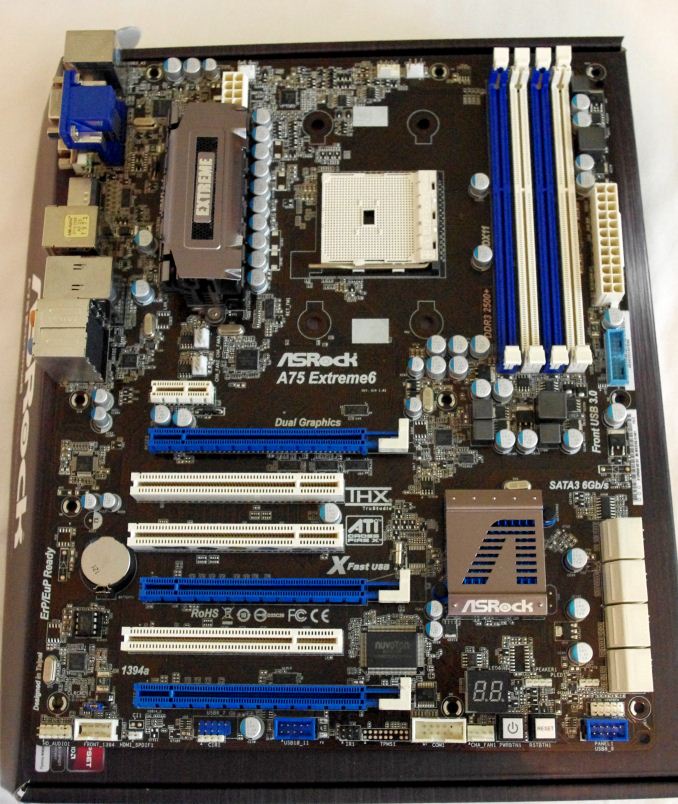
Llano throws a little oddball into the mix, being a true quad core unlike Trinity. The A75-UD4H from Gigabyte was the first one to hand, and offers two PCIe slots at x8/x8. Like the Core2Duo setup, we are not SLI enabled.
After finding an A8-3850 CPU as another point against the A6-3650, I pulled out the A75 Extreme6, which offers three-way CFX as x8/x8 + x4 from the chipset as well as the configurations offered by the A75-UD4H.
For Trinity: The Gigabyte F2A85X-UP4
Technically A85X motherboards for Trinity support up to x8/x8 in Crossfire, but the F2A85X-UP4, like other high end A85X motherboards, implements four lanes from the chipset for 3-way AMD linking. Our initial showing on three-way via that chipset linking was not that great, and this review will help quantify this.
For AM3: The ASUS Crosshair V Formula
As the 990FX covers a lot of processor families, the safest place to sit would be on one of the top motherboards available. Technically the Formula-Z is newer and supports Vishera easier, but we have not had the Formula-Z in to test, and the basic Formula was still able to run an FX-8350 as long as we kept the VRMs cool as a cucumber. The CVF offers up to three-way CFX and SLI testing (x16/x8/x8).
The Memory
Our good friends at G.Skill are putting their best foot forward in supplying us with high end kits to test. The issue with the memory is more dependent on what the motherboard will support – in order to keep testing consistent, no overclocks were performed. This meant that boards and BIOSes limited to a certain DRAM multiplier were set at the maximum multiplier possible. In order to keep things fairer overall, the modules were adjusted for tighter timings. All of this is noted in our final setup lists.
Our main memory testing kit is our trusty G.Skill 4x4 GB DDR3-2400 9-11-11 1.65 V RipjawsX kit which has been part of our motherboard testing for over twelve months. For times when we had two systems being tested side by side, a G.Skill 4x4 GB DDR3-2400 10-12-12 1.65 V TridentX kit was also used.
For The Beast, which is one of the systems that has the issue with higher memory dividers, we pulled in a pair of tri-channel kits from X58 testing. These are high-end kits as well, currently discontinued as they tended to stop working with too much voltage. We have a sets of 3x2 GB OCZ Blade DDR3-2133 8-9-8 and 3x1 GB Dominator GT DDR3-2000 7-8-7 for this purpose, which we ran at 1333 6-7-6 due to motherboard limitations at stock settings.
Our Core2Duo CPUs clearly gets their own DDR2 memory for completeness. This is a 2x2 GB kit of OCZ Platinum DDR2-666 5-5-5.
For Haswell we were offered new kits for testing, this time from Corsair and their Vengeance Pro series. This is a 2x8 GB kit of DDR3-2400 10-12-12 1.65 V.


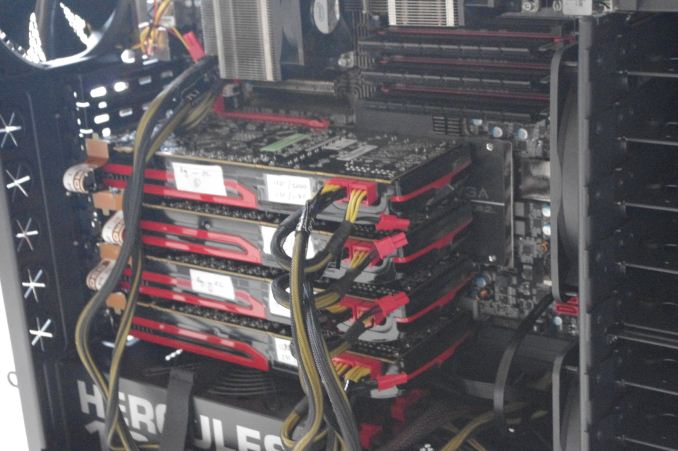
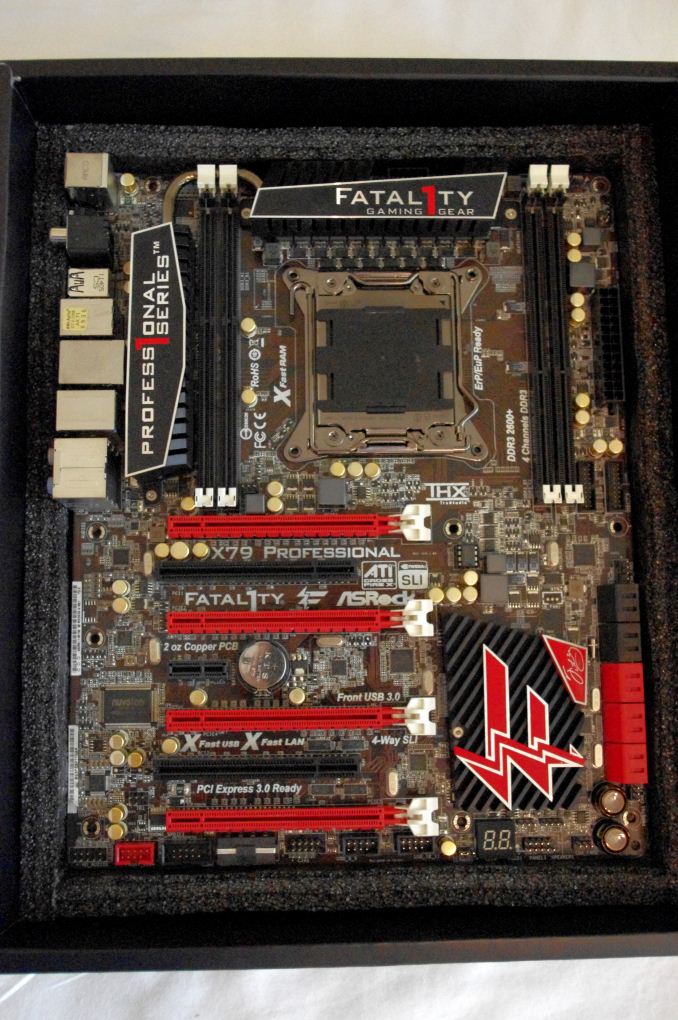
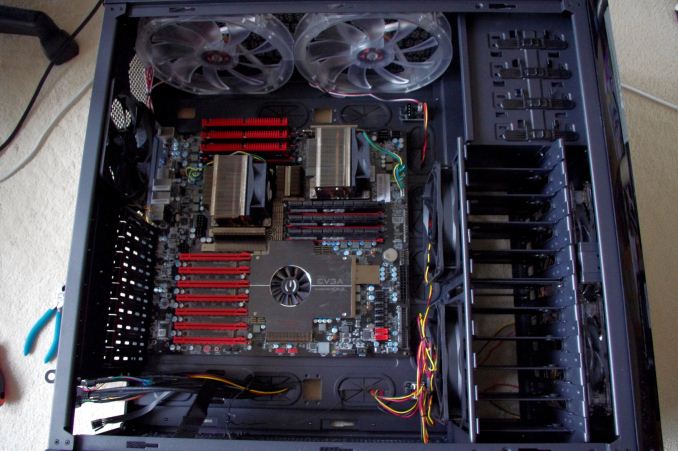
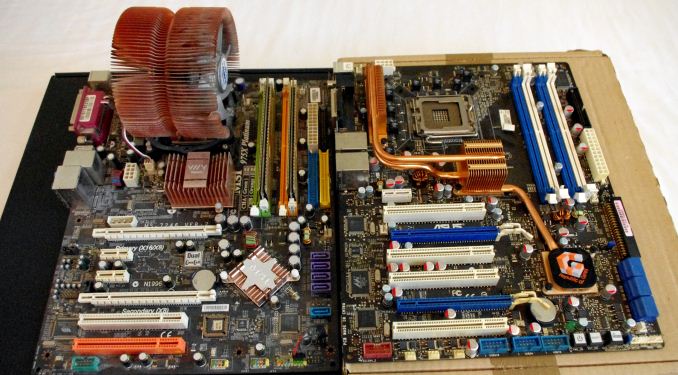
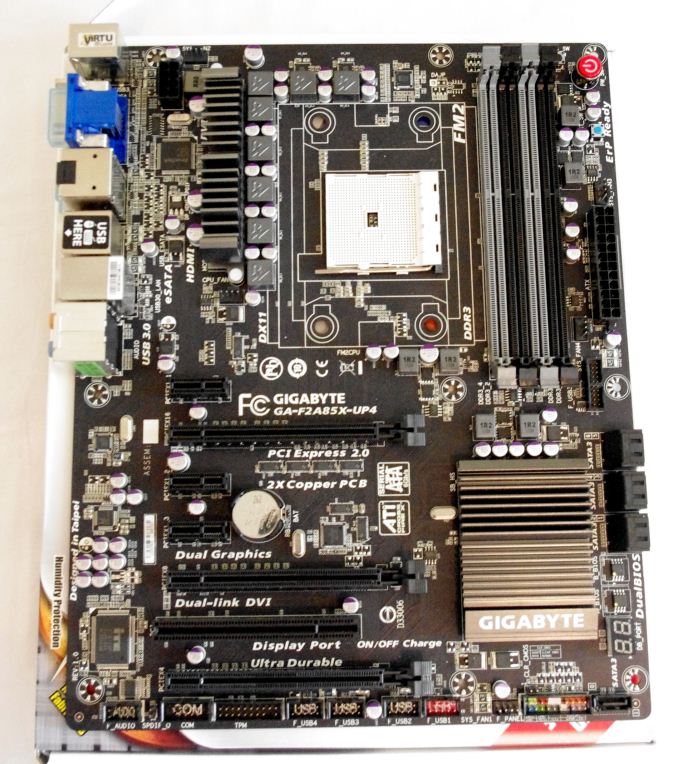
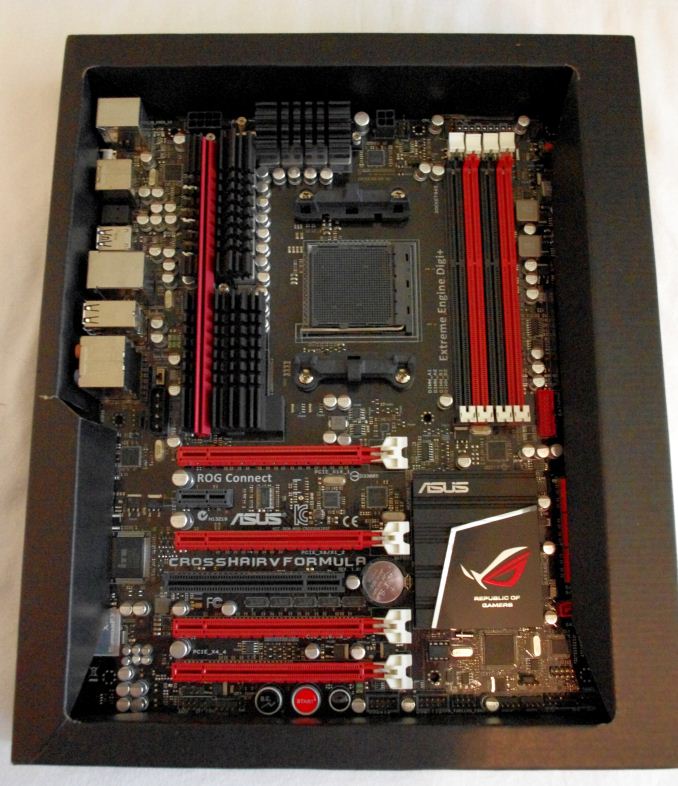

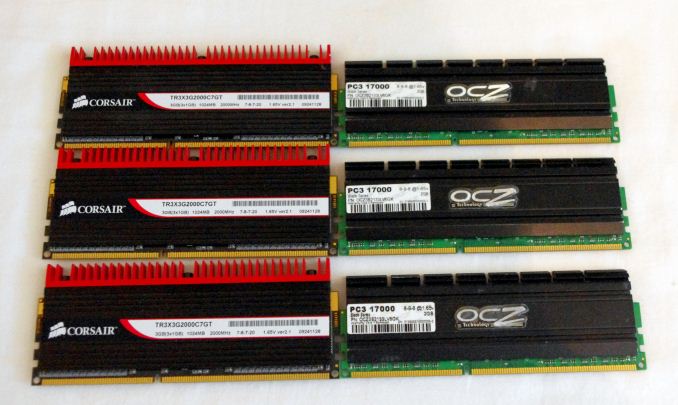
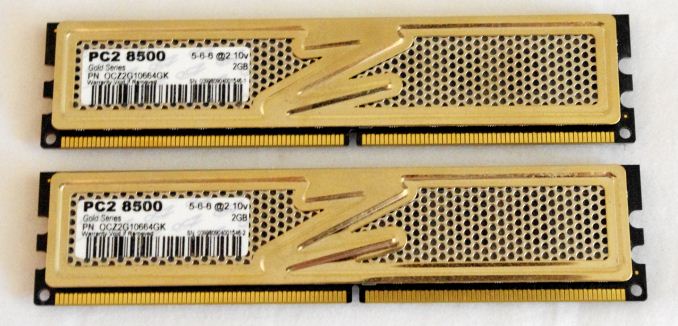
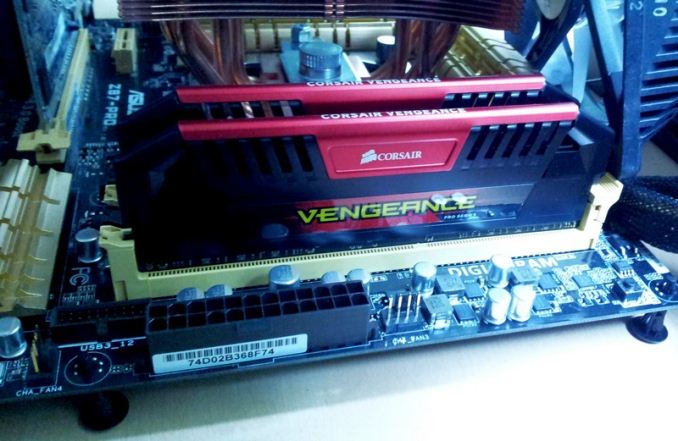








116 Comments
View All Comments
gonks - Tuesday, June 4, 2013 - link
Great work Ian! Definitely waiting to see i5-3570K added into the mix, to see how it compares to the i5-2500k (and the 3570k beeing more futureproof thanks to PCIe 3.0).Harby - Tuesday, June 4, 2013 - link
Excellent review, though it would be awesome to see World of Warcraft and Rift in there. Both are heavily relying on CPU.yougotkicked - Tuesday, June 4, 2013 - link
As always, thanks for the great article and hard work Ian.I'd really like to see how a few of the tests scale with overclocked CPU's, notably those in which the sandy bridge processors were competitive with ivy bridge and haswell parts. Obviously overclocking introduces a lot of variables into your testing, but it would be very interesting to see a few of the popular choices tested (sandy bridge parts @ 4.5 are quite common, and many users on such a system were waiting for haswell before they upgrade).
eBombzor - Tuesday, June 4, 2013 - link
Crysis 3 benchmarks PLEASE!!frozentundra123456 - Tuesday, June 4, 2013 - link
Interesting results, but very limited as well. Why test at a resolution used by only 4% of the players?I would have rather seen the results at 1080p, over a wider variety of games. Especially RTS games and newer games like crysis 3, FC3, and Tomb Raider. I tested Heart of the Swarm on my computer with a HD7770 and i5 2320 and was able to max out the cpu in a 10 player skirmish match at ultra, 1080p. So I am sure an A8-5600 would be limiting in that case.
Even considering the results only of the games tested, the A8-5600k seems a strange choice. The i3 seems just as valid, considering it is equal or faster in every game but one, while using less power.
makerofthegames - Tuesday, June 4, 2013 - link
Question - are those blank entries for the Xeons because they could not run, or just that data was not collected for them?Awful - Tuesday, June 4, 2013 - link
Glad to see there's no reason to upgrade the i5-2500k in my desktop yet - still happily chugging away at 4.9GHz after 2 years!holistic - Tuesday, June 4, 2013 - link
Ian,Thank you, for your time, effort, and energy in compiling an encyclopedic database on the effects of cpu on single and multi gpu configurations, in alternate gaming/engine scenarios. Your work is insightful, informative, and wholly devoted to the science of benchmarking. This approach has helped me, as a relatively new computer enthusiast, to more deeply understand testing methodology in the computing field.
I am interested in the pure CPU benchmarks of Starcraft 2 with the 4770k and 4670k. I understand this game is not optimized, is directx9, and is extremely cpu limited with only 2 maximum cores active, and thus not in top priority for providing benchmarks. Will haswell be added to the benchmarking database for sc2?
Cheers,
Craig
khanov - Tuesday, June 4, 2013 - link
Ian, I have to say (again) that i7-3820 should be in this review.You say that i7-4770K is a better value proposition than Sandy Bridge-E (X79), I assume because you are only thinking of the expensive 6 core X79 CPU's. That changes if you do consider i7-3820.
X79 brings far better support for multi-gpu setups with enough PCIe lanes to feed multiple cards quite happily. No PLX needed. Pair that with an i7 3820 (cheaper than i7-3770K/i7-4770K) and you may find the performance surprisingly good for the price.
chizow - Friday, June 7, 2013 - link
I considered the 3820 numerous times (it's cheap at MC, same price as high-end 3770K/4770K) but I shy away because it inexplicably performs *WORST* than 2700K/3770K/4770K. I don't know why, it has more L3 cache, and is clocked higher before/after boost. Just an oddball chip.Besides, X79 as a platform was dated almost as soon as it released. PCIe 3.0 support is spotty with Nvidia (reg hack not guaranteed), no native USB 3.0 and no full SATA 6G support. I went for Z87 + 4770K instead because X79 + 3820 didn't offer any noticeable advantages while carrying a significant higher price tag (board price).